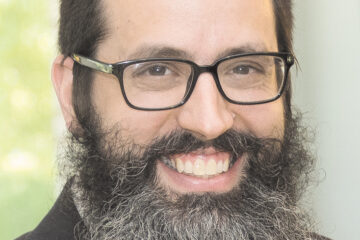X-Rated Purim in a PG world

By Rabbi Judy Chessin, Temple Beth Or, Washington Township, Ohio
Special To The Dayton Jewish Observer
Who doesn’t fondly recall those kiddie costume pageants and carnivals in celebration of the festival of Purim? Growing up, my religious school classmates and I relished dressing up as Queen Esther or King Ahashverus, and in my case “Megillah Gorilla,” all in hopes of winning the coveted first place in our temple’s Purim costume contest.
Hearing the story of Esther retold in its sanitized and abbreviated English, we kids cheered at the name of the heroic Mordechai and booed and stomped our feet at the mention of the wicked villain Haman.
I particularly delighted in the chorus of Once There was a Wicked, Wicked Man, never suspecting that its composer, Ray M. Cook, would one day become my mother-in-law.
There is no finer holiday for children than Purim, a time when Jewish kids can leave behind the sometimes somber strains and mournful tones of our faith and joyously celebrate with reckless abandon.
However, many of us never outgrow this child-centered Purim, and so we’ve missed the very adult, contemporary and relevant themes of the holiday. Few of us have bothered to explore the Book of Esther as grown-ups. It is a tale of the abuse of power, sexual slavery, armed self-defense, antisemitism and genocide: all very mature adult themes.
How sad that so few of us have outgrown the pediatric Purim pablum on which we were raised. Just consider a couple of adult Purim themes that are mirrored in our own contemporary society.
 When did Esther’s contest become reduced to a beauty pageant? After Queen Vashti’s fall from grace, King Ahashverus gathered all the beautiful virgins in the land (ostensibly the homely ones were left behind) and held them captive in the palace compound while they were anointed, exfoliated and fattened up for their night with the king. The virgins then went into the king’s chamber at nightfall, and came out in the morning, only to be demoted to the role of royal concubines, awaiting the king’s beck and call (Esther 2: 2-14).
When did Esther’s contest become reduced to a beauty pageant? After Queen Vashti’s fall from grace, King Ahashverus gathered all the beautiful virgins in the land (ostensibly the homely ones were left behind) and held them captive in the palace compound while they were anointed, exfoliated and fattened up for their night with the king. The virgins then went into the king’s chamber at nightfall, and came out in the morning, only to be demoted to the role of royal concubines, awaiting the king’s beck and call (Esther 2: 2-14).
Esther’s beauty and prowess were so remarkable that she became the chosen queen. Michael Fox, professor emeritus of Hebrew and Semitic studies at the University of Wisconsin, has written: “Though the selection of Esther is commonly thought of as a beauty contest, beauty is the stated criterion only for the first stage of the process, and that stage is not a contest…The actual competition, to take place after a year of beauty treatments, is a sex contest, with the winner being whoever can most please the king during her night with him.”
Perhaps if we really want to give the text of Esther a meaning and a purpose beyond lewd entertainment, it could serve as a starting point for an honest conversation about sexual slavery.
For 2011, the State Department has estimated as many as 27 million people, mostly women and children, have been taken without their consent for the global trade in enforced labor and sale for prostitution. Experts say there are forced laborers and sex workers in every U.S. state, and modern bondage generates an estimated $42.5 billion annually worldwide.
Shouldn’t the concept of sexual slavery and institutional rape, as extrapolated from the biblical narrative, initiate a wider discussion, serving as a springboard for Jewish awareness of and action against human trafficking?
Another hot adult topic in the Book of Esther is the concept of Jewish self-defense. Most of us believe, from a glossing over of Esther chapters 7 and 8, that the queen’s brave intervention put an end to Haman’s murderous intent.
Not so. A closer examination of the text reveals that the king did not halt the attack on the Jews; he merely allowed the Jews to bear arms and to launch a preemptive strike. Thus, on the 13th day of Adar, the day before Haman’s scheduled genocidal attack, “…the Jews mustered in their cities to attack those who sought their hurt; and no one could withstand them (Esther 9:2).”
The text of Megillat (the Scroll of) Esther gives us pause to consider the complex issues of Jewish self-defense through preemptive strikes. Israel has routinely been criticized for the 1967 “preemptive” strike in the Six-Day War, her successful air strike on Iraq’s nuclear reactor in 1981, and the ill-fated Israeli/Hezbollah War of 2006.
Fast forward about 2,500 years from the Purim tale, and the kingdom of ancient Persia has evolved into the modern day republic of Iran. Given the dire Iranian nuclear threat to Israel today, what bearing might this ancient text have for us today?
Life is no Purim carnival. It is complex and confounding. At times we can’t even agree on who is the wicked, wicked man, and God’s face seems as hidden as it is in the Scroll of Esther (which never mentions God).
Yet to be Israel, Jewish adults engaged in the struggle with God need to challenge the text and be challenged by it. So let us keep our sanitized version of Purim for our children, and let us likewise reclaim the mature, sophisticated and challenging text from which we might draw sustenance, wisdom, and find God’s hidden face as we grow up and grow older.





